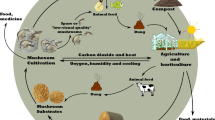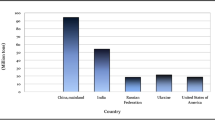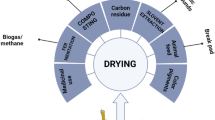Abstract
The combustion of fossil fuels is accompanied with a number of alarming problems such as fossil fuel depletion, increase in their prices, and emission of greenhouse gases. Thus, the need for the alternative renewable biofuels was increased to replace non-renewable fossil fuels. The sustainable use of non-edible feedstocks and waste for production of biofuels is a potential approach for reducing dependency on fossil fuels and mitigating environmental pollution. In the current study, the effects of carbon to nitrogen (C/N) ratios on methane yield during anaerobic co-digestion of Jatropha curcas de-oiled seed kernel and mango peels were evaluated in continuous reactors. The biogas potential and effects of acid pretreatment on J. curcas fruit were also evaluated during anaerobic batch digestion. The methane yield of co-digested mango peels and seed kernel (1:4 weight ratio based on volatile solids) was 61%, 50%, 36%, and 25% higher compared with the methane yields of mango peels, seed kernel, mango peels/seed kernel (2:1 w/w), and mango peels/seed kernel (1:1 w/w), respectively. The methane yields of the co-digestion of mango peels and seed kernel at 1:4, 1:1, and 2:1 ratios were 52%, 39%, and 32% of the theoretical yields, respectively, illustrating the importance of adjusting C/N ratio with the right amounts of co-substrate. The biogas yield of pretreated fruit coat was 7%, 22%, 34%, 50%, and 74% higher than that of the seed kernel, fruit coat (non-pretreated), de-oiled kernel plus seed coat (pretreated) (1.7:1, by weight), seed coat (pretreated), and seed coat (non-pretreated), respectively. Additionally, pretreatment of fruit coat and seed coat resulted in 22% and 47% higher biogas yields compared with their non-pretreated counterparts. This study revealed key substrate selection and pretreatment methods for increasing methane production from common seed oil production and agricultural wastes.

Graphical abstract




Similar content being viewed by others
Data availability
All relevant data are included in this manuscript.
Abbreviations
- ANOVA:
-
Analysis of variance
- C/N:
-
Carbon-to-nitrogen ratio
- CHNS:
-
Carbon, hydrogen, nitrogen, and sulfur
- MP + JSK:
-
Mango peels plus Jatropha curcas seed kernel
- NARC:
-
National Agriculture Research Council
- NL:
-
Normalized liter
- NmL:
-
Normalized milliliter
- SK + SC(H3PO4):
-
Jatropha curcas deoiled seed kernel mixed with dilute acid treated seed coat
- TS:
-
Total solids
- VFA:
-
Volatile fatty acids
- VS:
-
Volatile solids
References
Cui T, Li J, Yan Z, Yu M, Li S (2014) The correlation between the enzymatic saccharification and the multidimensional structure of cellulose changed by different pretreatments. Biotechnol Biofuels 7(1):134. https://doi.org/10.1186/s13068-014-0134-6
Xu N, Zhang W, Ren S, Liu F, Zhao C, Liao H, Xu Z, Huang J, Li Q, Tu Y (2012) Hemicelluloses negatively affect lignocellulose crystallinity for high biomass digestibility under NaOH and H2SO4 pretreatments in Miscanthus. Biotechnol Biofuels 5(1):58. https://doi.org/10.1186/1754-6834-5-58
Kim SB, Lee SJ, Lee JH, Jung YR, Thapa LP, Kim JS, Um Y, Park C, Kim SW (2013) Pretreatment of rice straw with combined process using dilute sulfuric acid and aqueous ammonia. Biotechnol Biofuels 6(1):109. https://doi.org/10.1186/1754-6834-6-109
Li P, He C, Li G, Ding P, Lan M, Gao Z, Jiao Y (2020) Biological pretreatment of corn straw for enhancing degradation efficiency and biogas production. Bioengineered 11(1):251–260. https://doi.org/10.1080/21655979.2020.1733733
Usmani Z, Sharma M, Gupta P, Karpichev Y, Gathergood N, Bhat R, Gupta VK (2020) Ionic liquid based pretreatment of lignocellulosic biomass for enhanced bioconversion. Bioresour Technol 304:123003. https://doi.org/10.1016/j.biortech.2020.123003
Hendriks A, Zeeman G (2009) Pretreatments to enhance the digestibility of lignocellulosic biomass. Bioresour Technol 100(1):10–18. https://doi.org/10.1016/j.biortech.2008.05.027
Abraham A, Mathew AK, Park H, Choi O, Sindhu R, Parameswaran B, Pandey A, Park JH, Sang B-I (2020) Pretreatment strategies for enhanced biogas production from lignocellulosic biomass. Bioresour Technol 301:122725. https://doi.org/10.1016/j.biortech.2019.122725
Dong L, Cao G, Tian Y, Wu J, Zhou C, Liu B, Zhao L, Fan J, Ren N (2020) Improvement of biogas production in plug flow reactor using biogas slurry pretreated cornstalk. Bioresour Technol Reports 9:100378. https://doi.org/10.1016/j.biteb.2019.100378
Kumar A, Sharma S (2008) An evaluation of multipurpose oil seed crop for industrial uses (Jatropha curcas L.): a review. Ind Crop Prod 28(1):1–10. https://doi.org/10.1016/j.indcrop.2008.01.001
Singh R, Vyas D, Srivastava N, Narra M (2008) SPRERI experience on holistic approach to utilize all parts of Jatropha curcas fruit for energy. Renew Energy 33(8):1868–1873. https://doi.org/10.1016/j.renene.2007.10.007
Raheman H, Mondal S (2012) Biogas production potential of jatropha seed cake. Biomass Bioenergy 37:25–30. https://doi.org/10.1016/j.biombioe.2011.12.042
Hessami M-A, Christensen S, Gani R (1996) Anaerobic digestion of household organic waste to produce biogas. Renew Energy 9(1-4):954–957. https://doi.org/10.1016/0960-1481(96)88438-2
Saidi R, Liebgott PP, Hamdi M, Auria R, Bouallagui H (2018) Enhancement of fermentative hydrogen production by Thermotoga maritima through hyperthermophilic anaerobic co-digestion of fruit-vegetable and fish wastes. Int J Hydrog Energy 43(52):23168–23177. https://doi.org/10.1016/j.ijhydene.2018.10.208
Ngan NVC, Chan FMS, Nam TS, Van Thao H, Maguyon-Detras MC, Hung DV, Van Hung N (2020) Anaerobic digestion of rice straw for biogas production. In: Sustainable Rice Straw Management. Springer, pp 65-92. https://doi.org/10.1007/978-3-030-32373-8_5
Suryawanshi P, Satyam A, Chaudhari A (2013) Integrated strategy to enhance biogas production from mango peel waste. Global Nest J 15(4):568–577
Chatha ZA, Muhammad U, Fatima F, Ali R (2019) Microbial study of mangoes and its control by non-thermal treatments. Pakistan J Phytopathol 31(2):207–210
Sluiter A, Hames B, Hyman D, Payne C, Ruiz R, Scarlata C, Sluiter J, Templeton D, Wolfe J (2008) Determination of total solids in biomass and total dissolved solids in liquid process samples. National Renewable Energy Laboratory, Golden, CO, NREL Technical Report No NREL/TP-510-42621:1-6
Nielsen HB, Angelidaki I (2008) Strategies for optimizing recovery of the biogas process following ammonia inhibition. Bioresour Technol 99(17):7995–8001. https://doi.org/10.1016/j.biortech.2008.03.049
Yenigün O, Demirel B (2013) Ammonia inhibition in anaerobic digestion: a review. Process Biochem 48(5-6):901–911. https://doi.org/10.1016/j.procbio.2013.04.012
Kigozi R, Aboyade A, Muzenda E (2014) Sizing of an anaerobic biodigester for the organic fraction of municipal solid waste. In Proceedings of the World Congress on Engineering and Computer Science (Vol. 2). http://www.iaeng.org/publication/WCECS2014/WCECS2014_pp659-663.pdf
Labatut RA, Gooch CA (2012) Monitoring of anaerobic digestion process to optimize performance and prevent system failure. In: In Proceedings of the Got Manure? Enhancing Environmental and Economic Sustainability 209. http://northeast.manuremanagement.cornell.edu/Pages/General_Docs/Events/Final.Proceedings.Document.pdf#page=213
Gerardi MH (2003) The microbiology of anaerobic digesters. John Wiley & Sons. https://books.google.com.pk/books?id=kHRhlkmT0ggC
Sen K, Mahalingam S, Sen B (2013) Rapid and high yield biogas production from Jatropha seed cake by co-digestion with bagasse and addition of Fe+2. Environ Technol 34(22):2989–2994. https://doi.org/10.1080/09593330.2013.798000
Haider MR, Yousaf S, Malik RN, Visvanathan C (2015) Effect of mixing ratio of food waste and rice husk co-digestion and substrate to inoculum ratio on biogas production. Bioresour Technol 190:451–457. https://doi.org/10.1016/j.biortech.2015.02.105
Gámez S, González-Cabriales JJ, Ramírez JA, Garrote G, Vázquez M (2006) Study of the hydrolysis of sugar cane bagasse using phosphoric acid. J Food Eng 74(1):78–88. https://doi.org/10.1016/j.jfoodeng.2005.02.005
Badshah M, Lam DM, Liu J, Mattiasson B (2012) Use of an automatic methane potential test system for evaluating the biomethane potential of sugarcane bagasse after different treatments. Bioresour Technol 114:262–269. https://doi.org/10.1016/j.biortech.2012.02.022
Angelidaki I, Sanders W (2004) Assessment of the anaerobic biodegradability of macropollutants. Rev Environ Sci Biotechnol 3(2):117–129. https://doi.org/10.1007/s11157-004-2502-3
Kumar P, Srivastava VC, Jha MK (2016) Jatropha curcas phytotomy and applications: development as a potential biofuel plant through biotechnological advancements. Renew Sust Energ Rev 59:818–838. https://doi.org/10.1016/j.rser.2015.12.358
Liang Y, Siddaramu T, Yesuf J, Sarkany N (2010) Fermentable sugar release from Jatropha seed cakes following lime pretreatment and enzymatic hydrolysis. Bioresour Technol 101(16):6417–6424. https://doi.org/10.1016/j.biortech.2010.03.038
Larsson S, Palmqvist E, Hahn-Hägerdal B, Tengborg C, Stenberg K, Zacchi G, Nilvebrant N-O (1999) The generation of fermentation inhibitors during dilute acid hydrolysis of softwood. Enzyme Microb Tech 24(3-4):151–159. https://doi.org/10.1016/S0141-0229(98)00101-X
Lawford HG, Rousseau JD (1998) Improving fermentation performance of recombinant Zymomonas in acetic acid-containing media. In: Biotechnology for Fuels and Chemicals. Springer, pp 161-172. Humana Press, Totowa, NJ. https://doi.org/10.1007/978-1-4612-1814-2_16
Yamamura M, Akashi K, Yokota A, Hattori T, Suzuki S, Shibata D, Umezawa T (2012) Characterization of Jatropha curcas lignins. Plant Biotechnol 29(2):179–183. https://doi.org/10.5511/plantbiotechnology.12.0515b
Becker K, Makkar HPS (1998) Toxic effects of phorbol esters in carp (Cyprinus carpio L). Vet Hum Toxicol 40:82–86
Haq A, Siddiqi M, Batool SZ, Islam A, Khan A, Khan D, Khan S, Khan H, Shah AA, Hasan F (2019) Comprehensive investigation on the synergistic antibacterial activities of Jatropha curcas pressed cake and seed oil in combination with antibiotics. AMB Express 9(1):67. https://doi.org/10.1186/s13568-019-0793-6
Hassan M, Oyewale A, Amupitan J, Abduallahi M, Okonkwo E (2004) Preliminary phytochemical and antibacterial investigation of crude extracts of the root bark of Detarium microcarpum. J Chem Soc Nigeria 29(1):26–29
American Public Health Association, American Water Works Association, Water Pollution Control Federation, Water Environment Federation.(1915) Standard methods for the examination of water and wastewater, (vol 2). American Public Health Association. https://books.google.com.pk/books?id=7sRLAAAAMAAJ
Acknowledgments
This study is part of NRPU project (6195/Federal/NRPU/R&D/HEC/2016).
Funding
This study was funded by Higher Education Commission of Pakistan and was part of NRPU project (6195/Federal/NRPU/R&D/HEC/2016). Abdul Haq was supported by postgraduate fellowship (HEC Indigenous Scholarship) granted by Higher Education Commission of Pakistan.
Author information
Authors and Affiliations
Contributions
AH and MB designed this study. AH performed the experiments. AK, SK, AAS, FH, FdlR, and SA participated substantially in discussion and modifications. All authors read and approved the final manuscript.
Corresponding author
Ethics declarations
Conflict of interest
The authors declare that they have no conflict of interest.
Code availability
Not applicable.
Additional information
Publisher’s Note
Springer Nature remains neutral with regard to jurisdictional claims in published maps and institutional affiliations.
Electronic supplementary material
ESM 1
(DOCX 15 kb)
Rights and permissions
About this article
Cite this article
Haq, A., Khan, A., Haji, K. et al. Enhancement of biogas yield during anaerobic digestion of Jatropha curcas seed by pretreatment and co-digestion with mango peels. Biomass Conv. Bioref. 12, 1595–1603 (2022). https://doi.org/10.1007/s13399-020-01064-7
Received:
Revised:
Accepted:
Published:
Issue Date:
DOI: https://doi.org/10.1007/s13399-020-01064-7




